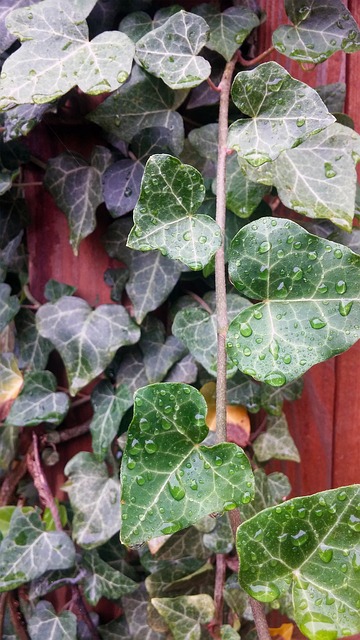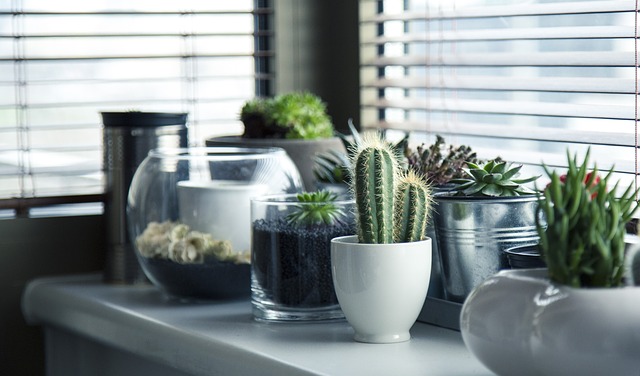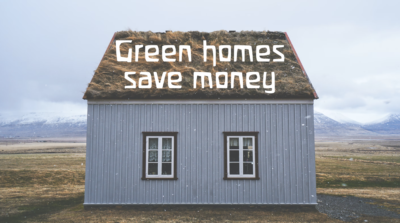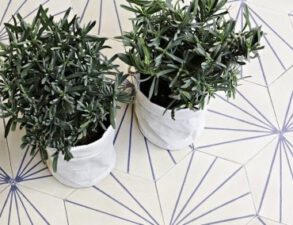Summertime, and the green outdoors beckons. It’s tempting to go for a healthy walk outdoors. But what if you live in an apartment, a bus ride away from a park? Or spend the best part of daylight hours in an office building? Most of Western humanity is already living in units stacked up one on top of another, where sidewalk trees and the occasional weedy empty lot is people’s only exposure to plants.
How about fresh air? Everyone’s walking around with their tongues hanging out from he summer heat, worse these days due to global warming. Why open windows when air conditioning offers instant relief?
Our urban work places and homes are like sealed environments. And in them, thousands of everyday objects subtly release chemical gases. Formaldehyde, for example, is present in grocery bags, waxed papers, facial tissues, and paper towels; cleaning products, cigarette smoke and cooking fuels. So is trichloroethylene, a chemical used in manufacturing ink, paints, lacquers, varnishes, and adhesives. Benzine is present in gasoline, inks, oils, paints, plastics, and rubber. Consider that every time you blow your nose, you come in contact with formaldehyde. When you print documents out, you’re unconsciously inhaling minute amounts of benzine.

Long-term exposure to these, and other common pollutants, takes a deadly toll on our health.
No one’s going back to using cloth handkerchiefs or hand-copying papers. But we should look for ways to get pollutants out of the enclosed environments we live in. A partial solution lies with Mother Nature – green your space.
Back in 1989, NASA did a joint two-year study with the Associated Landscape Contractors of America on how to clean the air in entirely sealed environments, that is, spaceships. They concluded that to maintain good air quality inside a space ship, astronauts should grow living plants to absorb and synthesize pollutants, in effect “scrubbing” the air. The researchers write,
“Since man’s existence on Earth depends upon a life support system involving an intricate relationship with plants and their associated microorganisms, it should be obvious that when he attempts to isolate himself in tightly sealed buildings away from this ecological system, problems will arise. Even without the existence of hundreds of synthetic organic chemicals off-gassing into tightly sealed environments, man’s own waste products would cause indoor air pollution problems. The answer to these problems is obvious. If man is to move into closed environments,
on Earth or in space, he must take along nature’s life support system.”
This study generated others on air quality in submarines, and “sick buildings.” The interest hasn’t stopped there. A study conducted across America by the Harvard T.H. Chan School of Public Health and Brigham and Women’s Hospital concludes that women who live among plants live longer, by 12%, than those who don’t. Green women stay mentally healthier, too. The study was done over 8 years between 2000-2008, and involved 108,630 women.
“We were surprised to observe such strong associations between increased exposure to greenness and lower mortality rates,” said Peter James, research associate in the Harvard Chan School Department of Epidemiology. “We were even more surprised to find evidence that a large proportion of the apparent benefit from high levels of vegetation seems to be connected with improved mental health.”

More impressive statistics that emerged from the Harvard study: Women living in the greenest areas had a 34% lower rate of deaths related to respiratory diseases. Women’s deaths from cancer were 13% lower in homes where there was plenty of contact with trees and plants.
“We know that planting vegetation can help the environment by reducing wastewater loads, sequestering carbon, and mitigating the effects of climate change. Our new findings suggest a possible co-benefit — improving health — that presents planners, landscape architects, and policy makers with an potential tool to grow healthier places,” said James.
Women were the focus of the Harvard study, but clearly the green factor benefits men as well. Researchers suggest that cleaner air, the noise-buffering effect of large plants like trees, and “opportunities for physical activity” – meaning gardening – are the life-prolonging elements here.
I add, anyone who’s had pleasure in tending plants knows how therapeutic the gentle toil is. Gardening also provides opportunities for social interaction; getting together with other gardeners, having something valuable in common with all kinds of people. And even if you’re not a people person, caring for plants gives you the satisfaction of living things that respond to your attention with flourishing green beauty.

NASA recommends using plants set over a carbon filter system fitted with a fan. This may not be convenient for most home owners, but here’s their list of plants that effectively scrub out the environment:
Bamboo Palm (Chamaedorea seifrizii)
Aloe Vera (Aloe vera or A. Barbadensis)
Areca palms (Chrysalidocarpus lutescens)
Boston Fern (Nephrolepis exaltata v. Bostoniesis)
Chinese Evergreen (Aglaonema)
Chrysanthemums (Chrysanthemum morifolium)
Devil’s Ivy or pothos (Epipremnum aureum)
Dracaena “Janet Craig” (Dracaena Deremensis)
Dwarf Date Palm (Phoenix Roebelenii)
English ivy (Hedera helix)

Ficus/Weeping Fig (Ficus benjamina)
Flamingo Lily/Fleur (Anthurium andraeanum)
Kimberly Queen Ferns (Nephrolepis obliterata)
Lady Palm (Rhapis excelsa)
Peace Lily (Spathiphyllum)
Philodendron
Pineapple plants
Rubber plants (Ficus elastic)
Snake Plant/Mother-in-Law’s Tongue (Sansevieria trifasciata)
Spider Plant (Chlorophytum comosum)
 : Harvard T.H. Chan School of Public Health
: Harvard T.H. Chan School of Public Health
: NASA, Landscape Plants For Indoor Air Pollution Abatement




